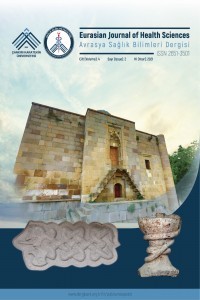Hemşirelik Öğrencilerinin Kanıt Temelli Uygulama Yetkinlikleri
Kanıt, Kanıta Dayalı Uygulama, Hemşirelik, Öğrenci Hemşire
Evidence-Based Practical Competencies of Nursing Students
Evidence, Evidence-Based Practice, Nursing, Student Nurse,
___
- Akın B, Ege E. (2008). Teaching Research in Nursing. Journal of Cumhuriyet University School of Nursing,12(3):60-69.
- Alqahtani N, Oh KM, Kitsantas P, & Rodan M. (2020). Nurses' evidence-based practice knowledge, attitudes and implementation: A cross-sectional study. Journal of clinical nursing, 29(1-2):274–283.
- Aydın Y, Adıgüzel A, Topal EA. (2015). Determination of Attitudes of Midwives and Nurses towards Scientific Studies. Journal Of Human Rhythm, 1(4):168-175.
- Burns HK, Foley SM. (2005). Building a Foundation for an Evidence-Based Approach to Practice: Teaching Basic Concepts to Undergraduate Freshman Students. Journal of Professional Nursing, 21(6):351–357.
- DuGan JE. (2019). "Keeping You in the Know": The Effect of an Online Nursing Journal Club on Evidence-Based Knowledge Among Rural Registered Nurses. Computers, informatics, nursing : CIN, 37(4):190–195.
- Emiroğlu ON, Ünlü H, Terzioğlu F, Bulut H. (2005). Nurses’ Vıews On Theır Research Actıvıtıes and Theır Vıewstowards Research and Nurses’ Needs Of Knowledge. Journal of Research and Development in Nursing, 5(1):64 – 86.
- Hickman LD, DiGiacomo M, Phillips J, Rao A, Newton PJ, Jackson D, Ferguson C. (2018). Improving evidence based practice in postgraduate nursing programs: A systematic review: Bridging the evidence practice gap (BRIDGE project). Nurse education today, 63: 69–75.
- Institute of Medicine (US) Committee on the Robert Wood Johnson Foundation Initiative on the Future of Nursing, at the Institute of Medicine. (2011). The Future of Nursing: Leading Change, Advancing Health. Washington (DC): National Academies Press (US).
- Iradukunda F, & Mayers PM. (2020). Rwandan nursing students' knowledge, attitudes and application of evidence-based practice. Curationis, 43(1):e1–e7.
- Jacobs SK, Rosenfeld P, Haber J. (2003). Information literacy as the foundation for evidence-based practice in graduate nursing education: a curriculum-integrated approach. J Prof Nurs, 19(5):320-328.
- Kelleci M, Gölbaşı Z, Yılmaz M, Doğan S. (2008). The Views Of Nurses, About Carrying Out Research And Utilization Of Research Results In Nursing Care In A University Hospital. Journal Of Research and Development in Nursing, 10(2):3-16.
- Kirk JW, & Nilsen P. (2016). Implementing evidence-based practices in an emergency department: contradictions exposed when prioritising a flow culture. Journal of clinical nursing, 25(3-4):555–565.
- Koç Z, Bal C, Sağlam Z. (2020). Detection of Perception of Male Student Nurses about Nursing. Maltepe University Journal of Nursing Science and Art, Symposium Special Issue, 318-323.
- Koota E, Kääriäinen M, Lääperi M, Melender HL. (2019). Emergency nurses’ Evidence-Based Practice attitudes, self-efficacy, knowledge, skills and behaviors before an educational intervention –Baseline of a Randomized Controlled Trial. Collegian. Küçük EÖ, Çakmak S, Kapucu S, Koç M, Kahveci R. (2017). Determination of Nursing Students’Awareness of Evidence-Based Nursing Practice. Journal of Hacettepe University Faculty of Nursing, 4(2):1–12.
- Lam CK, & Schubert C. (2019). Evidence‐Based Practice Competence in Nursing Students: An Exploratory Study With Important Implications for Educators. Worldviews on Evidence‐Based Nursing, 16: 161–168.
- Oh EG, & Yang YL. (2019). Evidence-based nursing education for undergraduate students: A preliminary experimental study. Nurse education in practice, 38: 45–51.
- Özdelikara A, Ağaçdiken S, Aydın E. (2016). Career Choices Of Nursing Students And Influencing Factors. Acı Badem University Journal of Health Sciences, 2:83-88.
- Person J, Spiva L, Hart P. (2013). The culture of an emergency department: An ethnographic Study. International Emergency Nursing, 21:222–227.
- Pickler RH. (2020). Year of the Nurse: Take the Challenge. Nursing research, 69(1):1–2.
- Republic of Turkey Ministry of Health. (2010). Nursing Regulation (2010).
- Ruzafa-Martinez M, Lopez-Iborra L, Moreno-Casbas T, Madrigal-Torres M. (2013). Development and validation of the competence in evidence based practice questionnaire (EBP-COQ) among nursing students. BMC Med Educ,13:19.
- Ryan EJ. (2016). Undergraduate nursing students' attitudes and use of research and evidence-based practice - an integrative literature review. Journal of clinical nursing, 25(11-12):1548–1556.
- Sampson FC, Goodacre SW, Cathain AO. (2014). Interventions to improve the management of pain in emergency departments: systematic review and narrative synthesis. Emerg Med J., 31: e9–e18.
- Saunders H, Stevens KR, & Vehviläinen-Julkunen K. (2016). Nurses' readiness for evidence-based practice at Finnish university hospitals: a national survey. Journal of advanced nursing, 72(8):1863–1874.
- Van der Goot WE, Keers JC, Kuipers R, Nieweg R, & de Groot M. (2018). The effect of a multifaceted evidence-based practice programme for nurses on knowledge, skills, attitudes, and perceived barriers: A cohort study. Nurse education today, 63:6–11.
- Yava A, Tosun N, Çiçek H, Yavan T, Terakye G, Hatipoğlu S. (2007). Validity and reliability of "Barriers Scale" in utilization of research results by nurses. Gülhane Medical Journal, 49:72-80.
- Yıldız E, Güngörmüş Z. (2016). The Validity And Reliability Study of The Turkish Version of The Evidence Based Practice Evaluation Competence Questionnaire. Nurse Education Today, 45:91-95.
- Yurtsever S, Altıok M. (2006). Evidence-Based Practice and Nursing. Fırat University Journal of Health Sciences, 20(2): 159-166.
- Yayın Aralığı: Yılda 3 Sayı
- Başlangıç: 2018
- Yayıncı: Çankırı Karatekin Üniversitesi
Flavonoidlerin Kanser Gelişimi ve Seyri Üzerine Etkileri
Fatmanur Şirin ŞENGÜN, Aliye ÖZENOĞLU
D Vitamini Eksikliği ve Obezite İlişkisi
Respiratuvar Sinsityal Virüs Enfeksiyonunda Platelet Lenfosit Oranı
Yasemın ARDICOGLU AKIŞIN, Defne TARIM, Mustafa TURAN, Nejat AKAR
Toplumun Akılcı İlaç Kullanımına İlişkin Bilgi ve Uygulamalarının Belirlenmesi: Çankırı İli Örneği
Nilay ŞAHİN, Nefise Cevriye SUCU ÇAKMAK, Deniz Zeynep SÖNMEZ
Polikistik Over Sendromunun Beslenme Tedavisinde Berberinin Yeri
Hemşirelik Öğrencilerinin Kanıt Temelli Uygulama Yetkinlikleri
Yasemin ATEŞEYAN, Zeynep GÜNGÖRMÜŞ
Emine KARACAN, Esin SAPÇI, Zeynep GÜNGÖRMÜŞ
İki Doz Coronavac Aşısı Sonrası Heterolog veya Homolog Rapel Dozun Etkinliği, Çankırı Örneği
